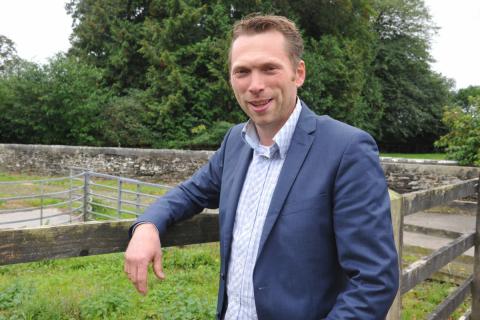24 October 2019
A dairy farmer has reduced his annual inputs of nitrogen to 135kg/hectare (ha) from 400kg while maintaining the same level of grass growth through a series of efficiency measures designed to reduce the impact of his farming operation on the environment.
As Wales makes the case for a farmer-led approach to nutrient management, Dutch dairy farmer Rick de Vor assured Welsh farmers that proposed changes could be financially beneficial to their businesses as well as the environment.
During a joint Farming Connect and AHDB Dairy event at Gelli Aur College Farm, Llandeilo, Mr de Vor spoke of the initiatives Dutch farmers are delivering to meet environmental expectations while assuring Welsh farmers that change could be good for their businesses.
“I make it work for me and I now have a better income as a result,’’ he insisted.
Mr de Vor milks 115 cows producing an average of 9050 litres of milk per cow annually, at 4.51% butterfat and 3.63% protein.
He farms 45ha in Utrecht and 7ha of that is canal water. “That presents problems with nitrogen, if levels in the water get too high we have penalties,’’ he said.
There are a number of government regulations in place in Holland governing nitrogen use and ammonia emissions, including a closed period for spreading slurry from September 1st to February 14th and a requirement for every dairy farm to have capacity for storing slurry for 10 months.
But some initiatives are being led by farmers, a programme known as The Sustainable Dairy Change.
“We have chosen to be proactive,’’ said Mr de Vor. “If you try to be better than the government wants you to be you can make your own plans to have lower nitrogen and CO2 emissions.’’
The initiative was launched last year and the results are hopeful, he said.
Farmers have set a goal to increase the average longevity of a milking cow from 4.5 years to 5.5 years to reduce the number of youngstock that need to be reared as replacements.
Eighty per cent of dairy farmers now graze their herds to reduce ammonia emissions – an increase from 65%. “A lot of farmers have changed their model of production,’’ said Mr de Vor, who grazes his cows for more than 200 days of the year.
By producing more energy from on-farm renewable schemes, ammonia losses had been reduced by more than 20%.
Another measure farmers take to reduce ammonia in their manures is to add water sourced from their canal systems – this has the effect of cutting ammonia levels by 50% while also increasing the availability of the usable nitrogen in the slurry, said Mr de Vor.
He has gone further than the requirement of regulation, including applying his final dressing of slurry at the beginning of July, despite the closed period not starting until September 1st. “The nitrogen in slurry is only usable for six to eight weeks, after that it is not usable so there is no point in applying it.’’
And he waits until the first or second week of March to apply slurry, although he could do so from February 15th. “It is too wet to apply it before then,’’ he said.
Farmers in the Netherlands are required to notify the authorities when they intend to spread slurry and mustn’t apply it within two metres of a watercourse.
By law they must test their soils every four years – Mr de Vor aims to have every paddock at 5.6pH or higher and he grows an abundance of red clover in his grass leys for its nitrogen fixing properties.
Farmers also monitor urea levels in their milk – if it is 22% or higher they must take action as that urea is excreted as ammonia.
Although this range of initiatives has had environmental benefits, Mr de Vor expressed concern at new rules proposed by the Dutch government to cut numbers of cows, pigs and poultry by 40% from January 1st 2020. The government says this action is needed because nitrogen deposits in nature reserves in Holland are too high.
“If this happened it wouldn’t be possible to have a good income from farming any more,’’ Mr de Vor maintained.
Farming Connect, which is delivered by Menter a Busnes and Lantra, is funded by the European Agricultural Fund for Rural Development and Welsh Government.

